While waiting at the Bagan airport for our 7:30 am flight to Mandalay , the northernmost city in Myanmar on our trip ,
we began chatting with a couple from the north of The Netherlands, Ricardo
and Wilmke. They mentioned they owned their own business and came to Myanmar on a brief trip after visiting their son who was interning at a hotel in Phuket, Thailand.

Hot air balloons over Bagan en route to the airport.
Airport at Bagan aka Nyaung U or Oo.
Air KBZ's logo: We loved flying the national airline all over Myanmar as they provided complementary wet wipes upon boarding plus free meals and beverages. We didn't think much of their 'TSA' agents though as they were unable to detect the bottles of water we put in our carry on bags. Only Air Asia staff noticed, and asked me to remove, my money belt when I went through security.
The flight from Bagan to Mandalay was only 30 minutes long but it took about an hour’s
drive by ‘share taxi’ to get to our hotel in the city.
After
checking in and dumping our bags in our room, we were headed out on foot to
discover Mandalay by 10:45 . When Mandalay was founded in 1857 by King
Mindon because of a Buddhist
prophecy saying a great metropolis would be built at the foot of the hill, it
replaced the town of Amarpura Mandalay is located 400 miles north of Yangon and is about 260 ft above sea level. It was the country’s
last royal capital and remains a notable Buddhist center.
Our hotel was basically on the SW corner of a huge moat that
surrounded the Royal Palace
Our first destination was a large pagoda but we stopped in at Sacred Heart
Church
We arrived at Shwekgimint Pagoda a short time later. Photos
from there:
The oldest pagoda in Mandalay ,
it was erected in 1167 by Prince Minshinsaw, the exiled son of King Alaungsithu
of Bagan.
The Buddha image was consecrated by the prince himself. It was the first time I remember seeing that the prayer
space was separated for male worshipers and female worshipers in a Buddhist temple.
Steven pointed out the prayer beads hanging for people to
borrow.
The Pagoda was a huge complex with many buildings that we enjoyed wandering through.
Something interesting for sale on the street as we walked to the library!
We walked next to the Cultural Museum Myanmar .
Photos from Cultural Museum and Library:
It was very, very hard to read any of the displays as none
of the lights were on in any of the rooms. Since there was no security staff, I
asked one of the women at the front desk to please turn on the lights but she
said they didn’t work. The only lighting came from the small upper windows, not
an optimal solution when trying to learn about a country’s history and culture,
you must admit. We joked that we were glad we hadn’t come on a cloudy day! I
wonder how many tourists visit the museum as we were the only ones there.
Perhaps others had done their due diligence and knew about the light situation
unlike us.
The sign said 'Traditional Myanmar 18th Century Ivory Chess Pieces.' Steven noticed they play chess differently in Myanmar .
He should know as he’s been on a chess tear on his iPad the last couple of
months!
19th Century Manuscript Cabinet from Mandalay.
A model of Mandalay's Shweinbin Monastery.
Hand Weaving Loom
We went upstairs to the Reading Room, above, where we saw
cloth covered manuscripts, below. I was surprised at how heavy the tomes were.
Even with the absence of lights, we really enjoyed walking through the small museum.
We wanted to visit the Royal Palace next but foreign
tourists could only enter through the East Gate which was in the opposite
direction from where we were. Normally we’d have hoofed the 2.5 miles there but
it was really hot, probably 85 degrees or so – I know you have no sympathy for
us as it is no doubt downright cold where you are reading this! We also wanted
to visit a number of pagodas after the palace before climbing Mandalay Hill
before sunset. We had a tough time getting a taxi but one finally stopped for
us. It was a shared taxi again so we had an unexpected tour of parts of
Mandalay we otherwise would never have seen while the driver dropped off his
other fare first.
Interesting sign at the East Gate Entrance to the Royal Palace!
When the taxi driver finally dropped us off at the East Gate
of the Royal Palace
We gladly rented bikes so we didn’t have to walk along the dusty road and ‘waste’ precious time. Thank goodness we weren’t going any great distances in the bikes as the steering and pedals on mine were all wonky and, oh yes, I had no brakes either!
Photos of the Army Fort from our bike ride:
Clock Tower
Photos from the
King Mindon built his Royal
Palace Mount
Meru
Steven decided to leave his shoes here for the entire time we wandered around the very large palace grounds. His poor tootsies got rather hot walking on the hot gravel later..
In the exact center of the Palace was the throne room called
the Lions’ Throne.
Promenade Hall
Lovely costumes in the Palace's North Dawe Hall.
We entered many of the palace's buildings but they were uniformly in a state of shocking disrepair. There were incredibly few exhibits in any of the buildings; all were in dire need of basic maintenance, coats of paint, cleaning and exterminators. The stench from pigeons in so many of the open buildings was positively overpowering.
After wandering around the very disappointing grounds and buildings of the Royal Palace for well over an hour, we heard some people talking in loud voices nearby. We went off in search and found the open gate below which turned out to be the entrance to the Palace Museum.
Photos of the Palace
Museum
The Palace Museum Entrance!
Beautifully carved wooden items above and below.
Guess the landscaping crew didn’t reach this
part of the grounds yet!
Steven had walked around the entire grounds without any shoes on as he had left them back outside the Lions' Throne, almost at the the Palace's entrance. He therefore did not want to climb the many steps up the Viewing Tower so I did that while he retrieved his shoes.
Photos from the Viewing Tower:
These photos give you a sense, I hope, of the magnitude of the palace and grounds. I thought the Palace looked more interesting from above than back down on the ground.
We decided to end our visit to the Palace as there were a number of monasteries and pagodas we wanted to
visit next located very closely together not much further north of the East
Entrance.
In the distance, a view of Mandsalay Hill, our destination at sunset.
We decided again to hop in a taxi for only 2,000 Kyat – the princely sum of $1.60! – so we could save both time and our legs. We asked the driver to drop us off at the
At one point the Monastery was part of the Royal
Palace Golden City
The wood detail work was exquisite.
I was curious what the Teak Monastery looked like underneath, so I peeked.
Words to that effect are beginning to look almost familiar by now! In the 1700s, the reigning queen decreed that women could
not enter this area and that policy hasn’t changed to this day.
I’ve mentioned in a previous post that no shoes can be worn
when entering any temples or pagodas. I cannot begin to tell you how truly
filthy our feet have gotten by the end of each day as we constantly have been
walking on dusty floors, on dirt and sand, on bird poop, you name it! I am sure
the people wearing lace up shoes must have rued the day they bought and brought
those shoes for pagoda traipsing. Ours luckily have been easy to pull off and on
but I will be so glad to chuck them one we hit terra firma in Denver on
December 18th . Mine look pretty shabby by now as they’ve been the
only shoes I’ve worn the whole trip except for 4 or 5 days when I briefly wore
others I mistakenly lugged along.
Impossible to not be impressed at every turn with the monastery's beautifully intricate carvings.
We walked for less than a minute to Atumashi Kyaung which
means ‘Incomparable Monastery.’ Kyaung means monastery in Burmese.
Photos of Atumashi Kyaung:
An 1890 fire destroyed the monastery taking with it 4
historic sets of Buddhist scriptures. This extraordinary masonry and teak
monastery was restored to the original plan.
The sign forbidding the use of drones to take photos certainly would not have been necessary very long ago.
Pretty ceiling with Buddhist prayer flags.
Background information about the monastery.
Ornate doorways.
I found Atumashi Kyaung to be very striking, particularly following so closely on the heels of our visit to the disappointing Royal Palace.
Impressive university entrance at the end of the street.
Newspapers showing Aung Sun Suu Kyi and the military leader after the recent elections.
We walked next to nearby Kuthodaw Pagoda but we could only see parts of it over the high stone wall until we could find the entrance.
Photos of Kuthodaw Pagoda:
Its central structure, the 100 ft high Maha Lawka
Marazein Pagoda, was erected in 1857 and was modeled on the Shwezigon
Pagoda we had seen a few days ago in Bagan. Sometimes Kuthodaw Pagoda is called the
‘world’s largest book’ as it was created by a team of 2,400 monks who required
almost 6 months to recite the text.
The canons were recorded on the marble slabs by devoted
Buddhist scholars; the letters were originally veneered with gold leaf.
Each stone structure contained parts of the Buddhist doctrine; thus each of the stark white monuments was considered a 'book.'
This is what one looked like.
Everyone was getting ready for a big festival taking place
in 2 hours to mark the 69th birthday of the monastery’s head monk.
This young woman was selling lovely embroidered pieces she and her mom had made. We had never seen anything like them before.
Some of the monks here were incredibly friendly and chatted
with us for several minutes. One of them wanted us to stay and enjoy the
festival and its free food and ice cream which sounded delightful but we
decided to leave as climbing Mandalay Hill was still our goal before sunset.
Steven had been to Mandalay some 45 years ago but he hadn’t climbed the hill then so we wanted to make sure we did
it this time.
Sign welcoming all visitors to the monk's birthday celebration.
Kuthodaw Pagoda is a UNESCO site.
We watched the head monk arrive for the birthday celebrations in his honor just as we were leaving.
Sandamuni Pagoda, our next stop, was just steps
away. Photos of it follow:
Sandamuni Pagoda was built on the site where King
Mindon located his provisional palace during construction of the Royal
Palace
The pagoda's security guard kindly walked with me around the pagoda and showed me where to take the best photos here at Sandamuni. How very thoughtful and considerate of him to have helped me like that.
It was hard for me to think of any places right then more photogenic than Kuthodaw and Sandamuni pagodas; their beauty just took my breath away.
Steven began chatting with 2 monks here who wanted to
practice their English. They mentioned they climb Mandalay Hill daily to
‘practice their ascent.’
We knew the sun would set soon and
that we still had almost an hour’s long walk up the many hundreds of steps to
the top of Mandalay Hill so we only spent a few minutes at Kyauktawgyi Pagoda.
Photos from Kyauktawgyi Pagoda:
Begun in 1853, the original plan was to model this after the
Ananda Temple
The huge Buddha figure was carved out of a single slab of
marble from the Sagaiing quarry and 10,000 men required 13 days to transport the
rock from the Irrawaddy River
Pretty darn spectacular, don't you think?
Finally, our long awaited climb up Mandalay Hill:
Once again, we had to remove our shoes at the bottom of the
steps before we began the long and, at times, steep ascent up the hill which
rises 790 ft above the surrounding countryside. The slopes are scaled via partially covered stairways as you can see above.
We lost track of the number of landings and pagodas as we climbed
up. About halfway up, we saw the first large temple which was said to contain 3
of Buddha’s bones.
We needed to pay close attention at times where we walked.
Views of Mandalay as we climbed:
Back to putting one foot in front of another as we still had hundreds of more steps to ascend.
Saw a number of desperately poor homes on the way up.
Gratifying to see this monk had gotten tired too although we never got to being that tired!
About two-thirds of the way to the top of the hill stood a gold plated statue of the Shweyattaw Buddha. His outstretched hand points to the place where the
It only took us 35 minutes to walk up the 1,729 steps to the
top, not as long as we thought because the walk was not particularly difficult.
Views atop Mandalay Hill:
This part of the walk down the steps wasn't a lot of fun, especially at night when there were very few lights on.
I thought of you, Suellen, when we saw the illuminated golf course.
We knew we had finally reached the bottom of the hill when we saw the pair of lions at this entrance.
I really loved the latter part of our day, especially touring the magical pagodas and then climbing Mandalay Hill. They were a perfect combination of unparalleled beauty and required some sustained exercise to enjoy too.
Posted on 12/3 from Kathmandu, Nepal.



















































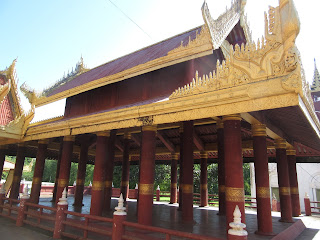

















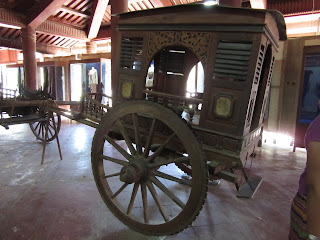
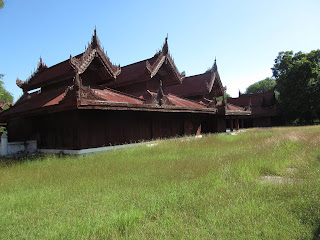


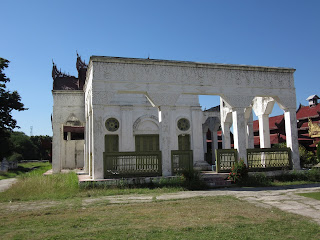

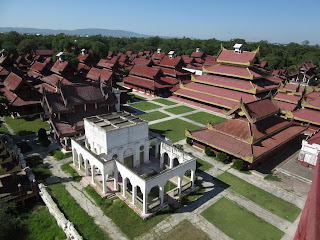











































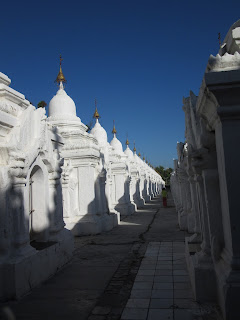







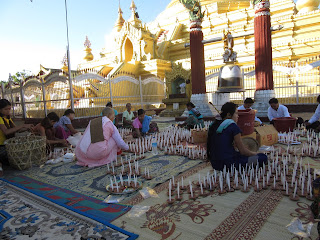
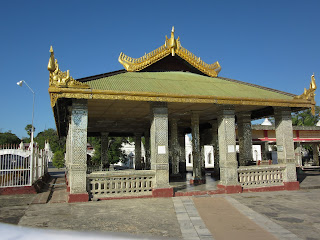





























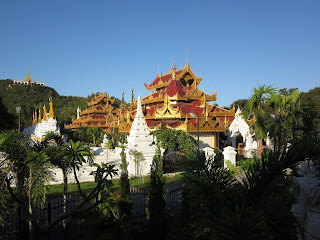







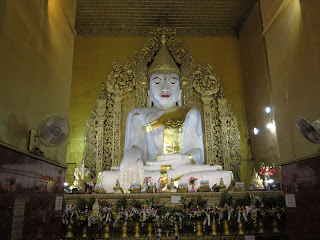













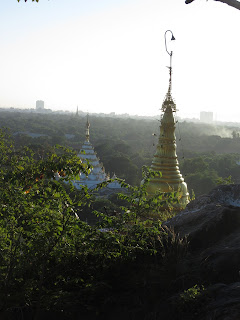



























Loved the view of all the white pagodas from Mandalay Hill. And sunset is almost always awesome. Keep those blogs coming!!! Lil Red
ReplyDelete